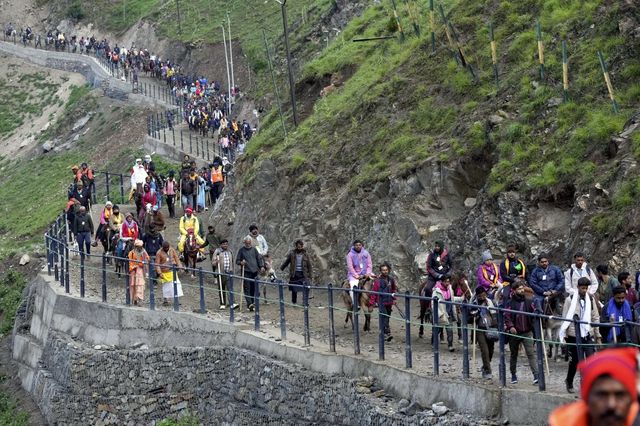The Amarnath Yatra 2025 went beyond being a spiritual journey to the holy cave at 3,880 meters in the Kashmir Himalayas—it became a movement for Swachhata and sustainability. With more than 4 lakh devotees participating, the Shri Amarnath Ji Shrine Board, in collaboration with the Jammu and Kashmir Government, ensured the Yatra aligned with the goals of Swachh Bharat Mission Urban 2.0, making it eco-friendly, plastic-free, and zero-landfill.
Scientific Waste Management: A Zero-Waste Yatra
The Yatra generated nearly 11.67 metric tons of waste daily, consisting of 3.67 MT of dry waste and 7.83 MT of wet waste. To manage this, the Shrine Board implemented a comprehensive waste segregation system.
-
1,016 twin-bin stations (blue for dry, green for wet) were installed along the Yatra route.
-
65 garbage collection vehicles, including twin-compartment trucks, ensured smooth waste transport.
-
3 organic waste composters (1-ton capacity each) processed wet waste, while dry waste was sent to Material Recovery Facilities (MRFs).
-
Sanitary waste bins were placed near female toilets, ensuring complete coverage.
This ensured 100% processing of waste with zero untreated landfill dumping.
Role of Volunteers and Swachhata Executives
The initiative was powered by Swachhata Executives, TULIP interns, and volunteers deployed across camps, lodgement centres, and langar sites. They spread awareness on waste segregation, discouraged single-use plastics (SUPs), and promoted hygiene practices. Nearly 1,300 SafaiMitras worked round the clock, ensuring 24×7 cleanliness throughout the Yatra route.
Plastic-Free Pilgrimage: Eliminating Single-Use Plastics
One of the boldest steps of the 2025 Yatra was the complete elimination of SUPs at langars.
-
Over 15,000 jute and cloth bags were distributed through 30+ kiosks.
-
Interactive campaigns like Plastic Lao, Thela Lejao and Bin It, Win It made waste segregation engaging.
-
Street plays, signage, and social media campaigns amplified the anti-plastic message.
This collective effort ensured that the Yatra set a benchmark in sustainable pilgrimages.
Sanitation and Hygiene: Smart and Inclusive Facilities
Over 1,600 mobile toilets were installed and cleaned twice daily. Each toilet was QR-enabled, allowing real-time feedback. More than 20,000 responses were received, ensuring continuous improvements in sanitation services.
Faecal sludge was collected using 39 de-sludging vehicles and treated at FSTPs, ensuring 100% treatment and hygienic conditions for pilgrims.
Green Pledge Campaign: Turning Awareness into Action
The Green Pledge campaign saw enthusiastic participation from more than 70,000 devotees. Pilgrims committed to follow swachhata practices and adopt sustainable alternatives.
-
Swachhata kits were distributed.
-
Pledge walls and selfie booths engaged devotees.
-
Role models called Responsible Yatris and Happy Faces were recognised for inspiring others.
This created a culture of responsible pilgrimage, linking faith with environmental action.
Faith Meets Sustainability
The Amarnath Yatra 2025 showcased how a sacred pilgrimage can align with sustainable development goals. With zero-waste systems, scientific waste management, and strong public engagement, it has set a national benchmark for eco-conscious pilgrimages.
By transforming devotion into action, the Yatra demonstrated that Swachh Bharat is not just a mission, but a collective responsibility—inspiring communities and cities across India.





